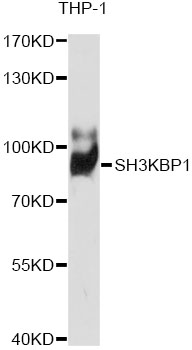-
Product Name
SH3KBP1 Polyclonal Antibody
- Documents
-
Description
Polyclonal antibody to SH3KBP1
-
Tested applications
WB
-
Species reactivity
Human, Mouse
-
Alternative names
SH3KBP1 antibody; CD2BP3 antibody; CIN85 antibody; GIG10 antibody; HSB-1 antibody; HSB1 antibody; MIG18 antibody; SH3 domain-containing kinase-binding protein 1 antibody
-
Isotype
Rabbit IgG
-
Preparation
Antigen: Recombinant fusion protein containing a sequence corresponding to amino acids 136-271 of human SH3KBP1 (NP_114098.1).
-
Clonality
Polyclonal
-
Formulation
PBS with 0.02% sodium azide, 50% glycerol, pH7.3.
-
Storage instructions
Store at -20℃. Avoid freeze / thaw cycles.
-
Applications
WB 1:500 - 1:2000
-
Validations

Western blot - SH3KBP1 Polyclonal Antibody
Western blot analysis of extracts of THP-1 cells, using SH3KBP1 antibody at 1:1000 dilution.Secondary antibody: HRP Goat Anti-Rabbit IgG (H+L) at 1:10000 dilution.Lysates/proteins: 25ug per lane.Blocking buffer: 3% nonfat dry milk in TBST.Detection: ECL Basic Kit .Exposure time: 90s.
-
Background
Adapter protein involved in regulating diverse signal transduction pathways. Involved in the regulation of endocytosis and lysosomal degradation of ligand-induced receptor tyrosine kinases, including EGFR and MET/hepatocyte growth factor receptor, through an association with CBL and endophilins. The association with CBL, and thus the receptor internalization, may inhibited by an interaction with PDCD6IP and/or SPRY2. Involved in regulation of ligand-dependent endocytosis of the IgE receptor. Attenuates phosphatidylinositol 3-kinase activity by interaction with its regulatory subunit (By similarity). May be involved in regulation of cell adhesion; promotes the interaction between TTK2B and PDCD6IP. May be involved in the regulation of cellular stress response via the MAPK pathways through its interaction with MAP3K4. Is involved in modulation of tumor necrosis factor mediated apoptosis. Plays a role in the regulation of cell morphology and cytoskeletal organization. Required in the control of cell shape and migration.
Related Products / Services
Please note: All products are "FOR RESEARCH USE ONLY AND ARE NOT INTENDED FOR DIAGNOSTIC OR THERAPEUTIC USE"
